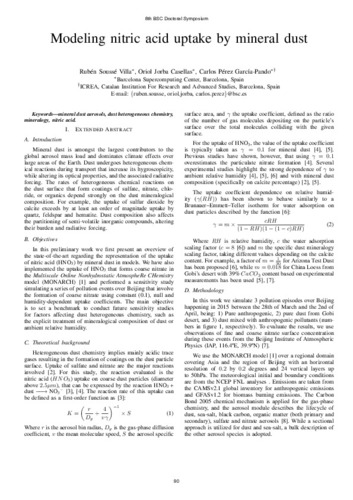Mostra el registre d'ítem simple
Modeling nitric acid uptake by mineral dust
| dc.contributor.author | Soussé Villa, Rubén |
| dc.contributor.author | Jorba Casellas, Oriol |
| dc.contributor.author | Pérez García-Pando, Carlos |
| dc.date.accessioned | 2021-06-04T07:52:53Z |
| dc.date.available | 2021-06-04T07:52:53Z |
| dc.date.issued | 2021-05 |
| dc.identifier.citation | Soussé Villa, R.; Jorba Casellas, O.; Pérez García-Pando, C. Modeling nitric acid uptake by mineral dust. A: . Barcelona Supercomputing Center, 2021, p. 90-92. |
| dc.identifier.uri | http://hdl.handle.net/2117/346629 |
| dc.description.abstract | Mineral dust is amongst the largest contributors to the global aerosol mass load and dominates climate effects over large areas of the Earth. Dust undergoes heterogeneous chemical reactions during transport that increase its hygroscopicity, while altering its optical properties, and the associated radiative forcing. The rates of heterogeneous chemical reactions on the dust surface that form coatings of sulfate, nitrate, chloride, or organics depend strongly on the dust mineralogical composition. For example, the uptake of sulfur dioxide by calcite exceeds by at least an order of magnitude uptake by quartz, feldspar and hematite. Dust composition also affects the partitioning of semi-volatile inorganic compounds, altering their burden and radiative forcing. |
| dc.format.extent | 3 p. |
| dc.language | en |
| dc.language.iso | eng |
| dc.publisher | Barcelona Supercomputing Center |
| dc.subject | Àrees temàtiques de la UPC::Informàtica::Arquitectura de computadors |
| dc.subject.lcsh | High performance computing |
| dc.subject.other | mineral dust aerosols |
| dc.subject.other | dust heterogeneous chemistry |
| dc.subject.other | mineralogy |
| dc.subject.other | nitric acid |
| dc.title | Modeling nitric acid uptake by mineral dust |
| dc.type | Conference report |
| dc.subject.lemac | Càlcul intensiu (Informàtica) |
| dc.rights.access | Open Access |
| local.citation.startingPage | 90 |
| local.citation.endingPage | 92 |
Fitxers d'aquest items
Aquest ítem apareix a les col·leccions següents
-
8th BSC Doctoral Symposium, 11th-13th May 2021 [33]
Book of abstracts


